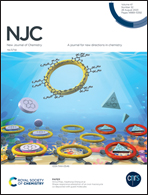Organic room temperature phosphorescence enhancement by grinding and adding water for humidity detection and anti-counterfeiting printing†
Abstract
Organic room temperature phosphorescence (RTP) materials with stimuli-responsive properties show great potential for application in information security and optoelectronic devices. Herein, we present a convenient and effective method to trigger and enhance the yellow RTP of small molecular weight host–guest materials by grinding and adding water. The phenomenon of grinding-excited RTP is attributed to the efficient energy transfer from the host to the guest molecules. After the introduction of water, the phosphorescence intensity of the doped material significantly increases, and the phosphorescence quantum yield (PhQY) increases to more than double. The enhancement is attributed to the formation of intermolecular hydrogen-bonding networks. The hydrogen-bonding networks can confine the molecular motion effectively and suppress non-radiative transitions. By virtue of the unique and sensitive water response characteristics of a doped material, anti-counterfeiting printing and humidity detection based on this material have been demonstrated.



 Please wait while we load your content...
Please wait while we load your content...